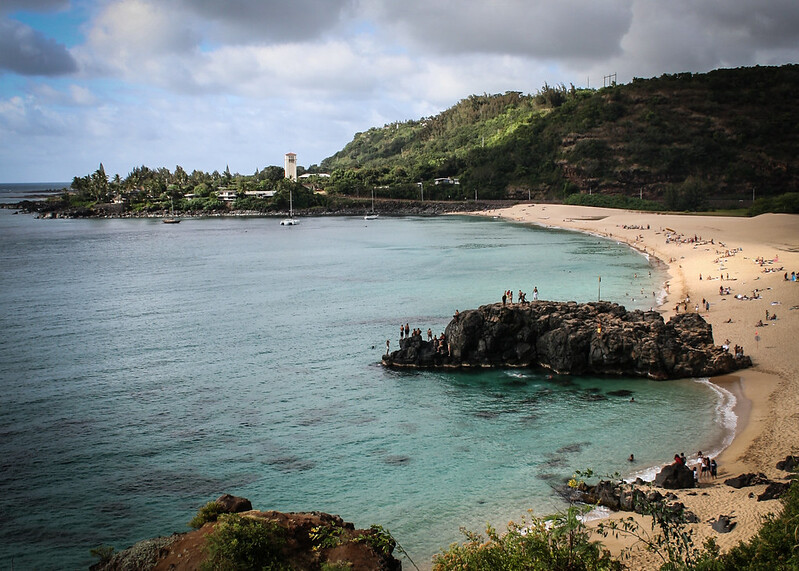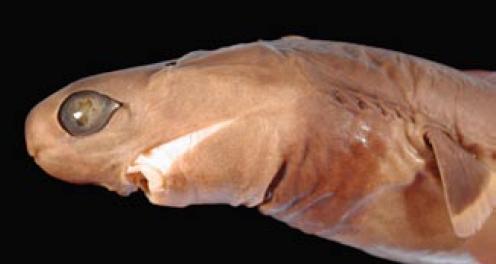Waimea Bay Beach, located on the North Shore of Oahu, sits at the mouth of the Waimea River.
The name Waimea means reddish waters. Because of it prime location near many sharks’ food sources, it sometimes is the only local beach where sharks are seen.
The inside coast of the bay is about 15 feet deep, and it gets progressively deeper. Waimea Bay Beach is one of the most popular beaches in Hawaii. Also, Waimea Falls is nearby the popular snorkeling spot, Sharks Cove.
With its proximity to Sharks Cove, you might be wondering: Does Waimea Bay Beach, HI have sharks? Is it safe to swim and surf in Waimea Bay?

Experts say sharks are relatively rare in the Waimea Bay area — and shark attacks on humans in Waimea Bay are essentially non-existent. Still, lifeguards work on active duty at the beach, and regularly patrol the beach with ATVs to help keep visitors safe. When they sight sharks, they post signs to alert visitors.
The types of sharks you might sometimes see in the waters surrounding Waimea Bay include:
- Sandbar sharks
- Blacktip sharks
- Tiger sharks
- Galapagos sharks
- Cookiecutter sharks
- And white sharks
Let’s take a closer look at the types of sharks that live near Waimea Bay, photos, shark attack history and statistics, and more.
Types of Sharks at Waimea Bay Beach, HI
Sharks in the water at Waimea Bay are not particularly common, but the ocean is a large place!
Here are some of the different types of sharks that may stray into these waters and may populate the surrounding areas.
Sandbar Sharks

Sandbar sharks are one of the most commonly seen types of shark in waters around Waimea Bay Beach. These sleek, silvery-gray sharks have flat snouts and a prominent ridge running along their backs that gives them their name.
These sharks are also called brown sharks. Normally not aggressive, there have been limited instances where they have attacked humans. Their size makes them a species to look out for.
They typically grow to be about 4-5 feet long, though some individuals can reach up to 10 feet in length.
Sandbar sharks are found throughout the Pacific and Atlantic Oceans, but they are most common in shallow coastal waters like those around Waimea Bay Beach.
These sandbar sharks feed on the baitfish that swim in the shallow waters of Waimea Bay. The river lets out tilapia nearby, which is one of their favorite food sources.
Sandbar sharks feed in groups. They will often circle their prey, driving the baitfish into a tight ball before attacking. This feeding behavior is called schools or shoals.
While they are not considered a danger to humans, sandbar sharks have been known to attack people who are swimming or surfing near them. These attacks are usually non-fatal and the result of the shark mistaking a person for one of their favorite prey items.
Because they inhabit such shallow waters, sandbar sharks can often be seen close to shore or even on beaches themselves, where they may approach people out of curiosity. Despite this tendency to get close to humans, sandbar sharks are not considered to be dangerous and there have been no recorded attacks by this species on humans.
Blacktip Sharks

Blacktip sharks are another type of shark that is commonly seen in waters around Waimea Bay Beach.
These sharks get their name from the black tips on their fins.
They are medium-sized sharks that typically grow to be between 5 and 7 feet long. Blacktip sharks are found throughout the world.
These sharks are found throughout the world in tropical and subtropical waters, often near coral reefs. In Hawaii, blacktip sharks are most common in the waters around the main Hawaiian islands.
While these sharks are not considered to be dangerous to humans, they have been known to occasionally attack swimmers and surfers, particularly if provoked.
Blacktip sharks are voracious predators, feeding on a wide range of small fish and invertebrates. Their prey items include squid, octopus, crustaceans, mollusks, rays, and other sharks. Because they hunt in schools or shoals, blacktip sharks often overwhelm their prey with sheer numbers before attacking.
Although they are not typically associated with human-shark incidents, blacktip sharks do pose a threat to people who enter the water near where they feed or congregate to give birth.
These aggressive hunters can be unpredictable when interacting with humans and may respond to provocation by biting or even attacking unsuspecting swimmers and surfers.
As such, it is important to always be aware of your surroundings and avoid swimming or surfing near known blacktip shark aggregation areas.
Tiger Sharks

Tiger sharks are known to inhabit the waters near Oahu. These dangerous sharks grow to be between 10 and 14 feet long and can weigh up to 2,000 pounds.
Tiger sharks are found in tropical and subtropical waters around the world, but they are most common in the Indo-Pacific region. In Hawaii, tiger sharks are most often seen in the waters around the main Hawaiian islands.
Tiger sharks get their name from the dark stripes on their bodies, which resemble a tiger’s markings. These stripes fade as the shark grows older.
Tiger sharks are one of the few types of shark that will eat just about anything they can find. Their diet includes fish, birds, seals, turtles, dolphins, and even other sharks.
Tiger sharks are known as some of the most aggressive sharks in the world. Hawaiian surfers are known to have been attacked by these predators.
Galapagos Sharks

Galapagos sharks are another type of shark that can be found in the waters near Waimea Bay Beach.
These large, powerful sharks grow up to 6 feet long and have a wide range of dietary habits, including fish, mollusks, crustaceans, sea birds, marine mammals and even other types of sharks.
They are usually dark gray or black with a white underbelly and light markings on their fins.
Galapagos sharks are large, powerful predators that can grow up to 6 feet long.
These sharks are found in tropical and subtropical waters around the world, but they are most common in the Indo-Pacific region. In Hawaii, Galapagos sharks are most often seen in the waters around the main Hawaiian islands.
Galapagos sharks are known to sometimes attack humans, and there have been cases where they have fatally attacked humans (though none in the Waimea Bay area).
Nearly all of these cases are considered provoked incidents, however.
Cookiecutter Shark

The Cookie cutter shark is a small but deadly predator found in the waters off of Waimea Bay Beach.
These sharks are about 2 feet long and have a truly unique appearance, with smooth grey skin, large black eyes, and sharp teeth that curve backward. The most notable feature of this species is its ability to use suction to feed on much larger prey.
Cookie-cutter sharks are often seen congregating near whales or other big marine mammals where they can easily feed on fish, squid, and smaller marine creatures that try to take advantage of the whale’s presence.
They also hunt by following ships into deeper water, where they use their suction-feeding technique to eat scraps from fishing lines or nets.
Despite their relatively small size, Cookie cutter sharks can be dangerous. They have been known to attack divers and snorkelers by biting them on the head or neck and taking a large chunk out of their skin or flesh.
These attacks can be quite traumatic, as the bite wounds can last for several weeks due to the shark’s sharp teeth.
Great White Shark

The White shark is a large, powerful predator found in the waters off of Waimea Bay Beach. These sharks can grow up to 20 feet long and are known for their size and strength as well as their distinctive white coloring.
White sharks are found in all major oceans around the world, but they migrate seasonally in search of food. In Hawaii, white sharks can be seen year-round, but they tend to stay close to shore near established feeding grounds.
White sharks are one of the most feared predators in the ocean, and with good reason. These powerful predators have been known to take down prey much larger than themselves, including whales and other marine mammals.
They use their sharp teeth and crushing jaws to tear apart their prey, and they have been known to attack humans.
Shark Attack History at Waimea Bay (Statistics)
Sharks have been sighted attacking dolphins in the Waimea Bay area. There is also a case from 29 years ago, dating back to 1992, of a surfer who went missing and his bodyboard was found with a bite out of it at Waimea Bay.
However, looking at official reports of Hawaii shark attacks, no incidents are found reported at Waimea Bay.
Overall, in the state of Hawaii, there have been just 6 deadly shark attacks since they have begun recording shark attacks. All of them have taken place on Maui.
Researchers say the peak attack times are in October and November.
Wrapping Up
Waimea Bay is on Oahu, and while sharks do inhabit the area, it is relatively safe for swimmers and surfers.
With the right precautions and not provoking sharks, swimmers should be safe. Just be sure to stay in groups and follow any direction or precaution from lifeguards.
And remember that shark attacks are extremely rare in general, and sharks are an incredibly important part of the ecosystem. Let’s appreciate them and not fear them!
For more guides, check out:
Hope this helps!